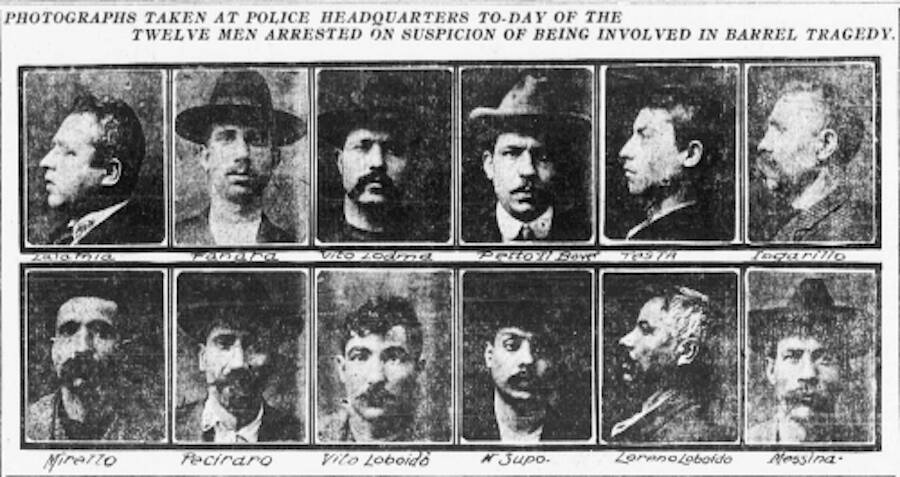Meanwhile, On the Other Side of Town…
A variety of other immigrant gangs frayed and fused. By the early 20th century, the Whyos had been wiped out by the encroaching efforts of the mostly-Jewish Eastman Gang and the multi-ethnic Five Points Gang.
Often described as the “most significant street gang to ever form in the United States to this point,” the Five Points Gang quickly got rid of the Eastman Gang with a 1903 ambush at a card game. The attack was reportedly the biggest shoot out in New York history at the time.

Public DomainBandit’s Roost by Jacob Riis. 1888.
By the early 1900s, the Five Points Gang, led by Sicilian boxer-turned-brothel owner, Paul Kelly, was the most powerful gang in New York City.
Part of that success stemmed from Kelly’s more egalitarian approach. Whereas other gangs had primarily been based on ethnic or religious lines, the Five Pointers were somewhat equal opportunists and picked promising members wherever they could find them.
The Five Points Gang would thus start the careers of future mafiosos Al “Scarface” Capone and Charles “Lucky” Luciano as low-level enforcers.
According to one estimate, from 1904 to 1907 alone, nearly 1 million Italians came to the United States and settled in New York. Of that number, an estimated 35,000 to 40,000 of them had been criminals in their old country.
Enter the American Mafia.
The First Mafiosos
The Mafia is believed to have originated in Sicily. It is defined by its hierarchical system of rules and traditions, particularly the practice of omertà, or silence.
The exact origins of the word “mafia” are unknown, but it’s been traced back to a Sicilian-Arabic slang expression that means “acting as a protector against the arrogance of the powerful.” Until the 19th century, the word mafioso did not reference a criminal but instead someone who was simply suspicious of authority.
In the 1860s, a play called I Mafiusi della Vicaria (Heroes of the Penitentiary) followed the story of inmates at a prison in Sicily who maintained their own hierarchy and rituals. The play is now credited with helping popularize the term “mafia” in regard to the criminal underworld.
When Mafia members talk about their organization, however, they tend to refer to themselves as “Cosa Nostra,” or “Our Thing.”
Whatever one calls it, this unique brand of organized crime entered the United States around the turn of the 20th century. Two Sicilian immigrants, Giuseppe Morello and his enforcer Ignazio “The Wolf” Lupo, established a new model of Cosa Nostra and effectively helped create the American Mafia.

Public DomainMugshots of reported Mafia members. Morello, as “Mirello,” is pictured in the lower left. 1903.
Having entered the United States sometime in the mid-1890s, Morello and Lupo ran their operations out of Little Italy, East Harlem, and The Bronx by the first decade of the 20th century. They used violence, threats, and extortion to build up their counterfeiting business.
In 1903, they committed their most infamous crime: the Barrel Murder. That April, the body of Morello associate Madonia Benedetto, was found with 18 stab wounds in the neck. The body had been stuffed into an old sugar barrel and abandoned on East 11th Street. There was a piece of paper in the man’s pocket with the words, “Come at once!” written in Italian.
Most believed that Benedetto was involved in the Morello counterfeiting operation. Police later found an angry letter written by Benedetto to Morello, accusing him of sending him on an “impossible mission” and accusing him of indifference toward his gang members. However, despite many arrests and a highly publicized trial, no one was ever convicted.
Likely inspired by the reaction the Morello Gang had gotten out of their crimes, other Italian groups in New York popped up.
One such group was known as La Mano Nera or “The Black Hand.” It was an anarchist criminal collective with roots in southern Italy, and it captured much of the crime spotlight in the 1920s. Although similar in some ways to the Mafia, it had some stark differences. For one thing, The Black Hand operated as a sort of Robin Hood organization — which the Mafia hated.
Famous for extorting victims with death threats, The Black Hand deliberately targeted wealthy Italian-Americans. The Black Hand was exactly the kind of organization that someone might hire to protect themselves from the Mafia — the Black Hand targeted the Mafia more than almost anyone else.
For instance, when mob leader and community figure Giosuè Gallucci, the “Mayor of Little Italy,” was killed by unknown gunmen in 1915, some thought The Black Hand members may have been responsible. It should be noted that this was never proven.
But either way, it was perhaps this exact kind of violence that finally prompted the city to take organized crime seriously.





